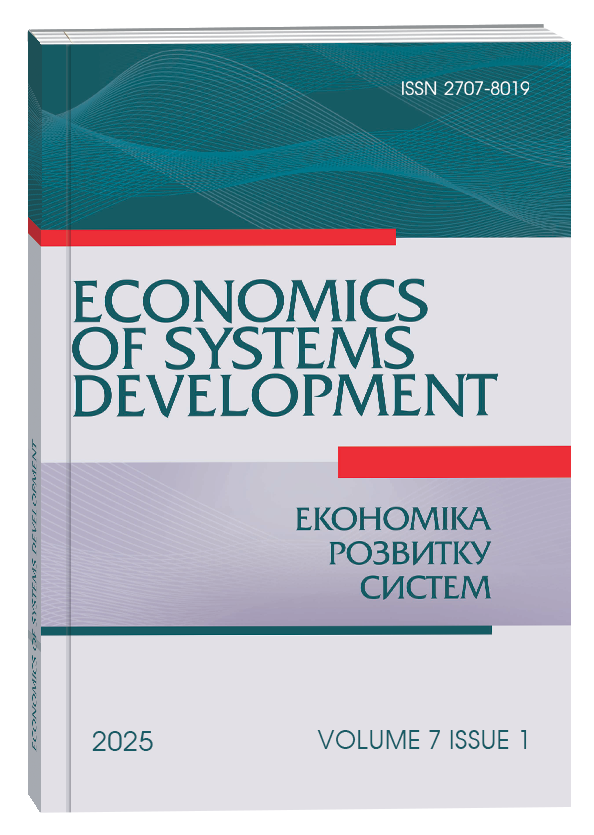MODELLING AND FORECASTING ECONOMIC INDICATORS OF UKRAINE BASED ON TREND MODELS
Анотація
The present study is devoted to the modelling and forecasting of the primary economic indicators of Ukraine, utilising econometric methodologies, with a particular focus on trend models. In the context of globalisation and economic instability, the study of the relationships between macro-economic variables is of particular relevance. This paper undertakes an analysis of the impact of such factors as the hryvnia/US dollar exchange rate, inflation, exports and imports on gross domestic product. The application of regression analysis enabled the identification of significant economic interdependencies and the determination of key variables with predictive value for the assessment of economic growth. The employment of the Python programming language enabled the processing of statistical data, the construction of multivariate regression models, and the forecasting of future macro-economic trends. The present study combines both theoretical and practical aspects of economic process analysis, which is realised by using multivariate regression to assess the relationships between gross domestic product, minimum wage, inflation and the national currency exchange rate. A significant finding is the existence of a close relationship between the exchange rate and gross domestic product, as evidenced by the high coefficient of determination of the model (R-squared = 0.98), indicating a strong explanatory power. The findings indicate that an augmentation in the US dollar exchange rate by one hryvnia results in a surge in gross domestic product exceeding 213 million UAH, under the assumption of constant factors. Furthermore, the study employed correlation analysis to identify the most significant variables. The strong correlation between the gross domestic product and key economic indicators, including the minimum wage (correlation coefficient of 0.99) and the consumer price index (correlation coefficient of 0.87), underscores their significant influence in shaping economic trends. The utilisation of trend analysis and data approximation through the employment of polynomial functions has facilitated the projection of gross domestic product and exchange rate growth in the 2025-2030 period. This suggests the possibility of stable economic development, even in the context of challenging macro-economic conditions.
Посилання
Cleophas T. J., Zwinderman A. H. (2024). Basic principles of regression analysis. Application of regularized regressions to identify novel predictors in clinical research, pp. 3–19. DOI: https://doi.org/10.1007/978-3-031-72247-9_1
Goloskokov O. E. (2008). Osnovy regresiinoho analizu: Navchalnyi posibnyk [Fundamentals of regression analysis: A textbook]. Kharkiv: NTU “KhPI”. (in Ukrainian) Available at: https://repository.kpi.kharkov.ua/handle/KhPI-Press/35098
Leontyuk-Melnyk O., Zakharchuk D. (2016) Ekonometrychne modeliuvannia dlia analizu ta prohnozuvannia osnovnoi diialnosti pidpryiemstva [Econometric modelling for analysis and prognostication of basic enterprise activity]. Galician economic bulletin (Tern.), vol 2(51), pp. 164-171. Available at: http://elartu.tntu.edu.ua/handle/123456789/20619
Maronna R., Thomas P. Ryan (2012). Modern regression methods (2nd ed.). Statistical Papers, vol 53(2), pp. 239–240. DOI: https://doi.org/10.1007/s00362-010-0347-0
Ministry of Finance of Ukraine. (n.d.). Available at: https://Ministry of Finance of Ukraine.com.ua/
Oliskevych M., Barabash, H. (2017a). Ekonometrychnyi analiz. Chastyna 1. Uzahalneni ekonometrychni modeli [Econometric analysis. Part 1 Generalized econometric models]. Available at: https://mmf.com.ua/images/stories/depart/mee/Ec2_L3_heteroskedasticity.pdf
Oliskevych M., Barabash H. (2017b). Ekonometrychnyi analiz. Chastyna 2. Uzahalneni ekonometrychni modeli [Econometric analysis. Part 2 Generalized econometric models]. Available at: https://new.mmf.lnu.edu.ua/wp-content/uploads/2018/03/lecture_2_econometrics2.pdf
Radzikhovska L., Husak L., Panchuk Y. (2021). Pobudova bahatofaktornoi regresiinoi modeli z vykorystanniam prohramnoho zabezpechennia Eviews [Building a multivariate regression model using Eviews software]. Computer-integrated technologies: education, science, production, vol 44, pp. 54–59. DOI: http://dx.doi.org/10.36910/6775-2524-0560-2021-44-09
Salyha S. Ya., Zavadska N. O. (2012). Trendovyi analiz hroshovykh potokiv iak zasib informatsiinoho zabezpechennia protsesu biudzhetuvannia v upravlinskomu obliku [Trend analysis of cash flows as a means of information support for the budgeting process in management accounting]. Business Inform, vol 6, pp. 178–187. Available at: http://jnas.nbuv.gov.ua/article/UJRN-0000040859


